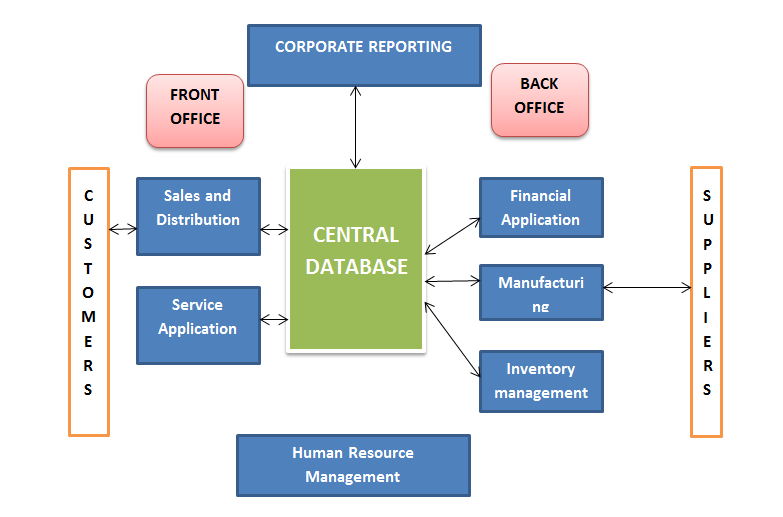Digital transformation is the rethinking of the customer experience, business models, and operations. Enterprise Resource Planning, or ERP, was coined by Gartner in the 1990s. The architecture of the software enables integration of modules, providing the flow of information between all functions within the enterprise in a visible manner.

Source: The Evolution of ERP Systems: A Historical Perspective
ERPs rely on technology that automates back-office functions while digital transformation makes use of a wide range of technologies to transform an enterprise’s business models.
In a recent guide by Forrester, author Duncan Jones states the ways in which ERP vendors fail to meet the demands of modern organizations, “Forrester Analytics data shows that two-thirds of software decision-makers in enterprises plan to replace or complement their enterprise resource planning (ERP) software with software-as-a-service (SaaS) applications or have already done so.”
But why is this the case? Jones states this is because the mega-suite era is over. In the last decade, business application strategies, like ERP, have failed to deliver the systems businesses need. Simply put, ERPs can’t handle business model complexity. They are monolithic in nature and can only work with existing modules and templates. ERP platforms are often:
- Complex to change: processes are already pre-built and modifying them is complicated and time-consuming. This forces businesses to stick with inefficient processes.
- Not customizable: not all business functions follow a one-size-fits-all approach.
- Provide fragmented insights: conventional ERP systems are not equipped with data analytics to provide data-driven insights.
- No 3rd party integrations: ERPs usually don’t have an open-API in which third-party applications can be easily coupled with enterprise applications.
- Doesn’t provide 100% coverage: No ERP supports all of a businesses’ needs. This results in the limited visibility of underlying processes.
“The enterprise resource planning (ERP) era is over. The ERP model of a single integrated suite to handle every process for every division within the enterprise did not work, for many reasons.” – Duncan Jones, VP, Principal Analyst.
IT leaders need a new strategy based on modern, open, smart, and flexible SaaS platforms. The most successful SaaS platforms will have an open-API, apply AI to automate processes, and innovate ahead of marketing trends.
So what can organizations turn to, to experience true digital transformation with their ERPs? An intelligent business process management system (iBPMS).
Choosing an iBPMS to Extend Your ERP
Now, don’t get confused with BPM and ERP, as both are used to manage processes. ERP is a type of software that provides users access to a suite of predefined applications. BPM is a discipline comprising strategies and techniques used to understand, improve, and automate business processes. iBPMs adds a layer of control and management for processes across an organization when extending an ERP.
An ERP is more focused on various business functions and the modules that support them. These business functions include HR, inventory management, accounting, etc. So let’s say you need software that manages one specific accounting workflow. An ERP vendor can only provide the entire accounting module to you. An iBPMS allows your organization to manage that workflow with a level of customization that isn’t available within an ERP.
As a central repository, ERPs can still have a place in your tech stack, but if you are looking for a more flexible approach, you need to extend your ERP with an iBPMS. iBPMS give organizations access to managing processes across disparate systems and applications beyond the span of an ERP with microservices architectures and productized integrations.
Organizations can benefit from the integrations of ERP and iBPMS as they uniquely compliment one another. Such integration offers:
- Extending functionality: adding functionality easily and cost-effectively to existing enterprise systems like a CMS or CRM.
- Filling the information gap: since an iBPMs connects disparate systems, information that is usually siloed in one application, becomes available throughout the application, thus enabling process efficiency.
- Enabling new processes: extend the capabilities of your ERP by enabling new processes with systems designed to process newer types of information.
In an iBPMs, each prescribed process has a digital link to the tools that are being used to execute that process. This allows businesses to monitor compliance, assess progress for key performance indicators, and more. In order to accomplish true digital transformation you need the following takeaways:
The customer is at the center. Legacy applications prevent IT leaders from delivering smart, user-centric, flexible applications that are required to take businesses on the path to digital transformation. Businesses need to take into consideration the customer’s needs in order to guide the addition of iBPMs to their stack.
Be agile. The goal of implementing iBPMs is to build agility into your organization. While you want to move quickly to start seeing results, you still need to do your due diligence in researching top vendors in the space. In the meantime, you can keep well-working legacy core applications while improving their effectiveness by using low-code digital process tools.
Embrace freedom. iBPMs solutions give businesses the opportunity to reassess traditional systems. Businesses no longer need to use old infrastructure to solve new business problems when you can custom build for every use case. Evaluate your key relationships and judge each product on its merits and shortcomings.
For enterprise case studies, read digital transformation examples.
Bottom Line
ERPs are a great solution for monolithic use cases, but if organizations truly want to get the most of their investment in ERPs, they need to extend their capabilities within an iBPMS. IT leaders should look to a flexible iBPMS to create a new environment for digital evolution. Keep in mind that embracing digital transformation means keeping it as a continuous process, not something you do once and then forget about it. Download our whitepaper Accelerate Digital Transformation with Low-Code iBPMS.





